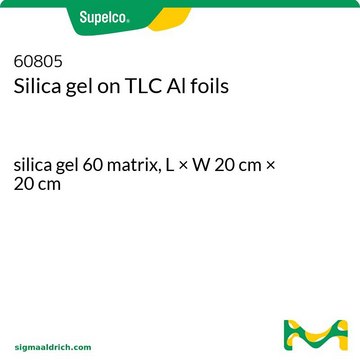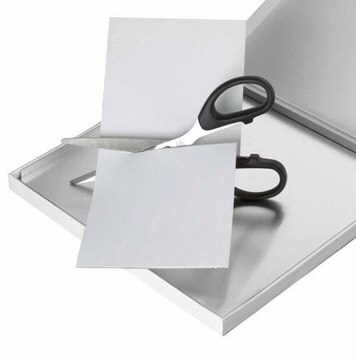60800
Silica gel on TLC Al foils
silica gel 60 matrix, L × W 10 cm × 20 cm, with fluorescent indicator 254 nm
Synonim(y):
TLC cards Silica gel
Zaloguj sięWyświetlanie cen organizacyjnych i kontraktowych
About This Item
Kod UNSPSC:
41115711
NACRES:
NB.21
Polecane produkty
Materiały
aluminum support
silica gel 60 matrix
Poziom jakości
jakość
with fluorescent indicator 254 nm
Właściwości
binder Organic Polymer
fluorescent indicator
opakowanie
pkg of 20 ea
producent / nazwa handlowa
Sigma-Aldrich
metody
thin layer chromatography (TLC): suitable
dł. × szerokość
10 cm × 20 cm
grubość warstwy
200 μm
wielkość cząstki
8.0-12.0 μm
wielkość porów
60 Å medium pore diameter
Szukasz podobnych produktów? Odwiedź Przewodnik dotyczący porównywania produktów
Powiązane kategorie
Opis ogólny
Silica gel is a rigid 3D network of colloidal silica. It is exclusively used as a support material for the active titanium(III) centers in Ziegler-Natta catalysts. Silica gel allows a controlled fragmentation resulting in the formation of uniform polymer particles with narrow particle size distribution and high bulk density. Silica gel is widely used as layer material for TLC. Plaster of Paris is generally used as binding agent to hold silica gel firmly to the TLC plates. Silica gel is applied as sorbent to the aluminium foils.
Zastosowanie
Silica gel on TLC Alu foils may be used to perform thin layer chromatography.
Ta strona może zawierać tekst przetłumaczony maszynowo.
Kod klasy składowania
11 - Combustible Solids
Klasa zagrożenia wodnego (WGK)
WGK 3
Temperatura zapłonu (°F)
Not applicable
Temperatura zapłonu (°C)
Not applicable
Wybierz jedną z najnowszych wersji:
Masz już ten produkt?
Dokumenty związane z niedawno zakupionymi produktami zostały zamieszczone w Bibliotece dokumentów.
Klienci oglądali również te produkty
Joseph C. Touchstone
Practice of Thin Layer Chromatography (1992)
A simple method for production of pure silica from rice hull ash
Kalapathy, U., A. Proctor, and J. Shultz.
Bioresource Technology, 73, 257-262 (2000)
Silica gel supported zirconocene dichloride/methylalumoxane catalysts for ethylene polymerization: Effects of heterogenation on activity, polymer microstructure and product morphology.
Janiak, Christoph, and Bernhard Rieger.
Angew. Makromol. Chem., 215, 47-57 (1994)
Nasz zespół naukowców ma doświadczenie we wszystkich obszarach badań, w tym w naukach przyrodniczych, materiałoznawstwie, syntezie chemicznej, chromatografii, analityce i wielu innych dziedzinach.
Skontaktuj się z zespołem ds. pomocy technicznej






